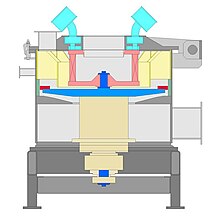Classifier mill
The Classifier is a combination of mill and classifier for fine grinding in the process technology . Finenesses of 7–150 µm are achieved. A mechanical fine impact mill and a dynamic air classifier are integrated into one housing. The structure of the classifier mill enables the two different process steps of fine grinding and classifying in just one machine.
construction
In a classifier mill, the fine impact mill and deflector wheel air classifier are arranged one above the other in a housing. Impact grinding takes place between the beater and the grinding track. The beaters are attached to a rotor disk and the grinding track is mounted on the housing wall. A rotor disk (also called a grinding disk) rests on a drive shaft. The classifier wheel is arranged horizontally above the rotor disk. The feed material is fed to the classifier mill above the grinding disk and ground between the grinding track and beater. The fine material obtained is removed centrally from the classifier wheel with the grinding and classifying air. The grinding and classifying air enters the interior of the housing through a nozzle below the rotor disk. An integrated air guide ring or good ring is used to deflect the air flow so that the fine material is transported to the classifier wheel.
functionality
The ground material is fed gravimetrically or pneumatically onto the grinding disc.
The grinding disc is equipped with radial beaters. The beaters capture the particles of the feed material, accelerate them and fling them against the grinding track, which is attached to the housing wall. Particles are crushed mainly due to the impact of the particles on the grinding track. Particles reach speeds of 40-100 m / s. Occasionally there is also a crushing by the collision of two particles.
Grinding and classifying air is fed to the grinding chamber. The air is fed in below the grinding disk. It is directed radially inward through the grinding zone between the rotor and the guide vane cage and the air is sucked out through the fine material outlet. This means that the grinding air transports impacted particles, so-called fine material, with the air flow. The impacted particles get to the classifier.
The separation of coarse and fine material is realized in a centrifugal force field . The air laden with particles is sucked inward against the centrifugal force by an air guide ring. The fine material is drawn off inwards through the classifier wheel and leaves the mill with the grinding and classifying air via a fine material outlet. The coarse material is rejected by the classifier wheel and returned to the grinding disc with the feed material. The coarse material is shredded again there.
Areas of application / area of application
Classifier mills are used in various industries in which dry matter is ground to a fineness between 7 and 150 µm. When grinding limestone, for example, target fineness of d97 = 10 µm can be achieved.
Well-known areas of application of classifier mills are the food industry , the chemical and pharmaceutical industry, the paint and varnish industry or in the plastics sector.
Classifier mills are equipped with either one drive or two drives, depending on the application. In classifier mills with only one drive motor, the grinding disk and classifier wheel have the same speed. This type of mill is used, for example, for flue gas desulphurization in power plants.
In classifier mills with two drives, the classifier wheel and grinding disc are each equipped with one drive. These mills can be used in a variety of applications. You are not limited to one type of grist and / or the desired grain size.
References
- Dr. Nied, fluid mechanics and thermodynamics in mechanical process engineering
